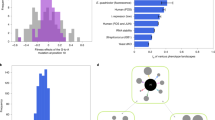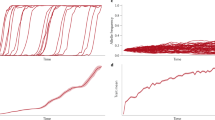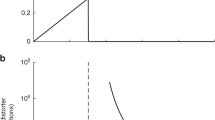Key Points
-
This article starts by reviewing the differences between various measures of fitness, for example, individual fitness, absolute fitness, relative fitness and geometric mean fitness.
-
Differences in fitness (when measured appropriately) can be used to derive selection equations, which show how natural selection changes the genetic composition of a population through time.
-
Quantitative geneticists derived the secondary theorem of natural selection, which shows how selection on fitness will change other, genetically correlated traits.
-
Fitness landscape models, whether continuous or discrete, can be used to analyse how natural selection will drive a population to the top of a fitness peak.
-
Evolutionary geneticists are currently pursuing several empirical approaches to the study of fitness, including direct fitness assays, microbial experimental evolution and the use of DNA sequence data to infer a history of positive natural selection.
-
The concluding section sketches several major unresolved problems in the experimental study of fitness.
Abstract
Although the operation of natural selection requires that genotypes differ in fitness, some geneticists may find it easier to understand natural selection than fitness. Partly this reflects the fact that the word 'fitness' has been used to mean subtly different things. In this Review I distinguish among these meanings (for example, individual fitness, absolute fitness and relative fitness) and explain how evolutionary geneticists use fitness to predict changes in the genetic composition of populations through time. I also review the empirical study of fitness, emphasizing approaches that take advantage of recent genetic and genomic data, and I highlight important unresolved problems in understanding fitness.
This is a preview of subscription content, access via your institution
Access options
Subscribe to this journal
Receive 12 print issues and online access
$209.00 per year
only $17.42 per issue
Buy this article
- Purchase on SpringerLink
- Instant access to full article PDF
Prices may be subject to local taxes which are calculated during checkout


Similar content being viewed by others
References
Brandon, R. N. Adaptation and evolutionary theory. Stud. Hist. Philos. Sci. 9, 181–206 (1978).
Brandon, R. N. Adaptation and Environment (Princeton Univ. Press, New Jersey, 1990).
Mills, S. & Beatty, J. The propensity interpretation of fitness. Philos. Sci. 46, 263–286 (1979).
Sober, E. The Nature of Selection (MIT Press, Massachusetts, 1984).
Sober, E. in Thinking About Evolution (eds Singh R. S., Krimbas, C. B., Paul, D. B & Beatty, J.) 309–321 (Cambridge Univ. Press, Cambridge, 2001).
Barker, J. S. F. in Adaptation and Fitness in Animal Populations (eds van der Werf, J., Graser, H.-U., Frankham, R. & Gondro, C.) 3–14 (Springer, Heidelberg, 2009).
Haldane, J. B. S. The Causes of Evolution (Longmans, Green & Co., Ltd, New York, 1932).
Dobzhansky, T. Genetics and the Origin of Species 3rd edn (Columbia Univ. Press, New York, 1951).
Dobzhansky, T. A review of some fundamental concepts and problems of population genetics. Cold Spring Harb. Symp. Quant. Biol. 20, 1–15 (1955).
Gillespie, J. H. Population Genetics: a Concise Guide (Johns Hopkins Univ. Press, Baltimore, 2004). A brief but clear introduction to mathematical population genetics. Little mathematical background is assumed.
Crow, J. F. & Kimura, M. An Introduction to Population Genetics Theory (Harper and Row, New York, 1970). The gold standard textbook of classical population genetics, including rigorous treatments of fitness and natural selection. The work is, in places, mathematically demanding.
Gillespie, J. Natural selection for variances in offspring number: a new evolutionary principle. Am. Nat. 111, 1010–1014 (1977).
Frank, S. A. & Slatkin, M. Evolution in a variable environment. Am. Nat. 136, 244–260 (1990).
Orr, H. A. Absolute fitness, relative fitness, and utility. Evolution 61, 2997–3000 (2007).
Felsenstein, J. Theoretical Evolutionary Genetics 408 [online], (2007).
Gillespie, J. H. Natural selection with varying selection coefficients — a haploid model. Genet. Res. 21, 115–120 (1973).
Gillespie, J. H. The Causes of Molecular Evolution (Oxford Univ. Press, Oxford, 1991).
Seger, J. & Brockman, H. J. in Oxford Surveys in Evolutionary Biology (eds Harvey, P. H. & Partridge, L.) 182–211 (Oxford Univ. Press, Oxford, 1987).
Bulmer, M. Theoretical Evolutionary Ecology 352 (Sinauer, Sunderland, Massachusetts, 1994).
Stearns, S. C. Daniel Bernoulli (1738): evolution and economics under risk. J. Biosci. 25, 221–228 (2000).
Levene, H. Genetic equilibrium when more than one ecological niche is available. Am. Nat. 87, 331–333 (1953).
Dempster, E. R. Maintenance of genetic heterogeneity. Cold Spring Harb . Symp . Quant . Biol. 20, 25–32 (1955).
Wallace, B. Topics in Population Genetics (Norton, New York, 1968).
Robertson, A. A mathematical model of the culling process in dairy cattle. Anim. Prod. 8, 95–108 (1966). A little-read but enormously important paper in the history of quantitative genetics. The paper introduces the secondary theorem of natural selection.
Price, G. R. Selection and covariance. Nature 227, 520–521 (1970).
Falconer, D. S. Introduction to Quantitative Genetics 2nd edn (Longman, UK, 1981).
Price, G. R. Extension of covariance selection mathematics. Ann. Hum. Genet. 35, 485–490 (1972).
Crow, J. F. & Nagylaki, T. The rate of change of a character correlated with fitness. Am. Nat. 110, 207–213 (1976).
Fisher, R. A. The Genetical Theory of Natural Selection (Oxford Univ. Press, Oxford, 1930).
Robertson, A. Selection in animals: synthesis. Cold Spring Harb. Symp. Quant. Genet. 20, 225–229 (1955).
Robertson, A. in Heritage from Mendel (ed. Brink, A.) 265–280 (Univ. Wisconsin Press, Madison, 1967).
Robertson, A. in Population Biology and Evolution (ed. Lewontin, R. C.) 5–16 (Syracuse Univ. Press, New York, 1968).
Ewens, W. J. An interpretation and proof of the fundamental theorem of natural selection. Theor. Pop. Biol. 36, 167–180 (1989).
Ewens, W. J. An optimizing principle of natural selection in evolutionary population genetics. Theor. Pop. Biol. 42, 333–346 (1992).
Edwards, A. W. F. The fundamental theorem of natural selection. Biol. Rev. 69, 443–474 (1994).
Lessard, S., Fisher's fundamental theorem of natural selection revisited. Theor. Pop. Biol. 52, 119–136 (1997).
Crow, J. F. Here's to Fisher, additive genetic variance, and the fundamental theorem of natural selection. Evolution 56, 1313–1316 (2002).
Kauffman, S. A. The Origins of Order 709 (Oxford Univ. Press, New York, 1993).
Orr, H. A. Genetic theories of adaptation: a brief history. Nature Rev. Genet. 6, 119–127 (2005).
Joyce, P. et al. A general extreme value theory model for the adaptation of DNA sequences under strong selection and weak mutation. Genetics 180, 1627–1643 (2008).
Wright, S. Evolution in Mendelian populations. Genetics 16, 97–159 (1931).
Wright, S. The roles of mutation, inbreeding, crossbreeding, and selection in evolution. Proc. 6th Int. Cong. Genet. 1, 356–366 (1932). Wright's famous description of adaptive (or fitness) landscapes.
Wright, S. Character change, speciation, and the higher taxa. Evolution 36, 427–443 (1982).
Coyne, J. A., Barton, N. H. & Turelli, M. A critique of Sewall Wright's shifting balance theory of evolution. Evolution 51, 643–671 (1997).
Maynard Smith, J. in The Scientist Speculates: an Anthology of Partly-Baked Ideas (ed. Good, I. J.) 252–256 (Basic Books, Inc., New York, 1962).
Maynard Smith, J. Natural selection and the concept of a protein space. Nature 225, 563–564 (1970). A brilliant description of the problem of increasing fitness by evolution through a discrete sequence space.
Gillespie, J. H. A simple stochastic gene substitution model. Theor. Pop. Biol. 23, 202–215 (1983).
Gillespie, J. Molecular evolution over the mutational landscape. Evolution 38, 1116–1129 (1984).
Kauffman, S. & Levin, S. Towards a general theory of adaptive walks on rugged landscapes. J. Theor. Biol. 128, 11–45 (1987).
Kauffman, S. A., Weinberger, E. D. & Perelson, A. S. in Theoretical Immunology: Part One (ed. A. S. Perelson) 349–382 (Addison-Wesley, New York, 1988).
Macken, C. A. & Perelson, A. S. Protein evolution on rugged landscapes. Proc. Natl Acad. Sci. USA 86, 6191–6195 (1989).
Macken, C. A., Hagan, P. S. & Perelson, A. S. Evolutionary walks on rugged landscapes. SIAM J. Appl. Math. 51, 799–827 (1991).
Perelson, A. S. & Macken, C. A. Protein evolution on partially correlated landscapes. Proc. Natl Acad. Sci. USA 92, 9657–9661 (1995).
Orr, H. A. The population genetics of adaptation: the adaptation of DNA sequences. Evolution 56, 1317–1330 (2002).
Orr, H. A. The distribution of fitness effects among beneficial mutations. Genetics 163, 1519–1526 (2003).
Orr, H. A. The probability of parallel adaptation. Evolution 59, 216–220 (2004).
Orr, H. A. Theories of adaptation: what they do and don't say. Genetica 123, 3–13 (2005).
Lewontin, R. C., Moore, J. A., Provine, W. B. & Wallace, B. (eds). Dobzhansky's Genetics of Natural Populations I-XLIII (Columbia Univ. Press, New York, 1981). An important compilation of Dobzhansky's experimental studies of fitness in natural populations of D. pseudoobscura.
Lewontin, R. C. The Genetic Basis of Evolutionary Change 346 (Columbia Univ. Press, New York, 1974).
Hedrick, P. W. Genetics of Populations Ch. 5 (Science Books International, Boston, 1983).
Hedrick, P. W. Murray, E. in Genetics and Biology of Fitness (eds Ashburner, M., Carson, H. L. & Thompson, J. N.) 61–104 (Academic, New York, 1983).
Christiansen, F. B. & Frydenberg, O. Selection component analysis of natural polymorphisms using population samples including mother-offspring combinations. Theor. Pop. Biol. 4, 425–445 (1973).
Bundgaard, J. & Christiansen, F. B. Dynamics of polymorphisms: I. Selection components of Drosophila melanogaster. Genetics 71, 439–460 (1972).
Lewontin, R. C. & Cockerham, C. C. The goodness-of-fit test for detecting natural selection in randomly mating populations. Evolution 13, 561–564 (1959).
Prout, T. The estimation of fitnesses from genotypic frequencies. Evolution 19, 546–551 (1965).
Prout, T. The estimation of fitnesses from population data. Genetics 63, 949–967 (1969).
Denniston, C. & Crow, J. F. Alternative fitness models with the same allele frequency dynamics. Genetics 125, 201–205 (1990).
Kreitman, M. in Evolution at the Molecular Level (eds Selander, R. K., Clark, A. G. & Whittam, T. S.) 204–221 (Sinauer Associates, Inc., Sunderland, Massachusetts, 1991).
Kreitman, M. The neutral theory is dead. Long live the neutral theory. BioEssays 18, 678–683 (1996).
Otto, S. P. Detecting the form of selection from DNA sequence data. Trends Genet. 16, 526–529 (2000).
Eyre-Walker, A. The genomic rate of adaptive evolution. Trends Ecol. Evol. 21, 569–575 (2006). A review of Eyre-Walker's approach to using DNA sequence data to estimate the proportion of amino acid substitutions driven by natural selection.
Hahn, M. W. Toward a selection theory of molecular evolution. Evolution 62, 255–265 (2008).
McDonald, J. H. & Kreitman, M. Adaptive protein evolution at the Adh locus in Drosophila. Nature 351, 652–654 (1991). The paper that introduced the most widely used statistical test of neutrality versus selection at the level of DNA sequences.
Begun, D. J. et al. Population genomics: whole-genome analysis of polymorphism and divergence in Drosophila simulans. PLoS Biol. 5, e310 (2007). A genome-wide analysis of molecular evolution in D. simulans . The paper provides evidence for frequent positive natural selection.
Smith, N. G. C. & Eyre-Walker, A. Adaptive protein evolution in Drosophila. Nature 415, 1022–1024 (2002).
Andolfatto, P. Adaptive evolution of non-coding DNA in Drosophila. Nature 437, 1149–1152 (2005).
Kim, Y. & Stephan, W. Detecting a local signature of genetic hitchhiking along a recombining chromosome. Genetics 160, 765–777 (2002).
Wright, S. I. et al. The effects of artificial selection on the maize genome. Science 308, 1310–1314 (2005).
Lenski, R. E. & Travisano, M. Dynamics of adaptation and diversification: a 10,000-generation experiment with bacterial populations. Proc. Natl Acad. Sci. USA 91, 6808–6814 (1994). A classic account of a real-time experimental evolution study in Escherichia coli.
Sniegowski, P. D., Gerrish, P. J. & Lenski, R. E. Evolutionof high mutation rates in experimental populations of E. coli. Nature 387, 703–705 (1997).
Bull, J., Badgett, M. & Wichman, H. Big-benefit mutations in a bacteriophage inhibited with heat. Mol. Biol. Evol. 17, 942–950 (2000).
Holder, K. & Bull, J. Profiles of adaptation in two similar viruses. Genetics 159, 1393–1404 (2001).
Travisano, M. & Lenski, R. E. Long-term experimental evolution in Escherichia coli. IV. Targets of selection and the specificity of adaptation. Genetics 143, 15–26 (1996).
Elena, S. F. et al. Evolutionary dynamics of fitness recovery from the debilitating effects of Muller's ratchet. Evolution 52, 309–314 (1998).
Bull, J. J. et al. Exceptional convergent evolution in a virus. Genetics 147, 1497–1507 (1997).
Wichman, H. A. et al. Different trajectories of parallel evolution during viral adaptation. Science 285, 422–424 (1999).
Elena, S. F. & Lenski, R. E. Evolution experiments with microorganisms: the dynamics and genetic bases of adaptation. Nature Rev. Genet. 4, 457–469 (2003).
Silander, O. K., Tenaillon, O. & Chao, L. Understanding the evolutionary fate of finite populations: the dynamics of mutational effects. PLoS Biol. 5, e94 (2007).
Betancourt, A. Genome-wide patterns of substitution in adaptively evolving populations of the RNA bacteriophage MS2. Genetics 181, 1535–1544 (2009).
Stern, D. L. & Orgogozo, V. The locus of evolution: how predictable is genetic evolution? Evolution 62, 2155–2177 (2008).
Hoekstra, H. E. & Coyne, J. A. The locus of evolution: evo–devo and the genetics of adaptation. Evolution 61, 995–1016 (2007).
Rokyta, D. R. et al. An empirical test of the mutational landscape model of adaptation using a single-stranded DNA virus. Nature Genet. 37, 441–444 (2005).
Coyne, J. A. & Orr, H. A. Speciation (Sinauer Associates Inc., Sunderland, Massachusetts, 2004).
Acknowledgements
This work was suppported by a grant from the US National Institutes of Health.
Author information
Authors and Affiliations
Related links
Related links
FURTHER INFORMATION
Glossary
- Instar
-
A developmental stage of insect larvae.
- Random variable
-
A quantity that might take any of a range of values (discrete or continuous) that cannot be predicted with certainty but only described probabilistically.
- Covariance
-
A measure of association between two variables that characterizes the tendency for the two variables to covary around their means in a systematic way.
- Genetic drift
-
Random fluctuation in allele frequency owing to the sampling of gametes in a finite population.
- Interdemic selection
-
Selection wherein local populations (demes) compete with each other. Wright believed that fitter populations would also produce more migrants.
- NK model
-
A class of fitness landscape model that considers evolution through a discrete sequence space. The model allows the ruggedness of a landscape to be varied from very rugged (many local optima) to very smooth (one optimum) by changing one parameter.
- Hardy–Weinberg equilibrium
-
A state in which the frequency of each diploid genotype at a locus equals that expected from the random union of alleles (genotypes AA, Aa and aa will be at frequencies p2, 2pq and q2, respectively). These expectations are based on a stable population undergoing random mating in the absence of selection, new mutations and migration.
Rights and permissions
About this article
Cite this article
Orr, H. Fitness and its role in evolutionary genetics. Nat Rev Genet 10, 531–539 (2009). https://doi.org/10.1038/nrg2603
Issue Date:
DOI: https://doi.org/10.1038/nrg2603
This article is cited by
-
The transcriptome response of Enterobacter sp. S-33 is modulated by low pH-stress
Genes & Genomics (2024)
-
Caenorhabditis elegans foraging patterns follow a simple rule of thumb
Communications Biology (2023)
-
Indirect effects shape species fitness in coevolved mutualistic networks
Nature (2023)
-
Fitness, growth and transmissibility of SARS-CoV-2 genetic variants
Nature Reviews Genetics (2023)
-
Case Studies in the Assessment of Microbial Fitness: Seemingly Subtle Changes Can Have Major Effects on Phenotypic Outcomes
Journal of Molecular Evolution (2023)



